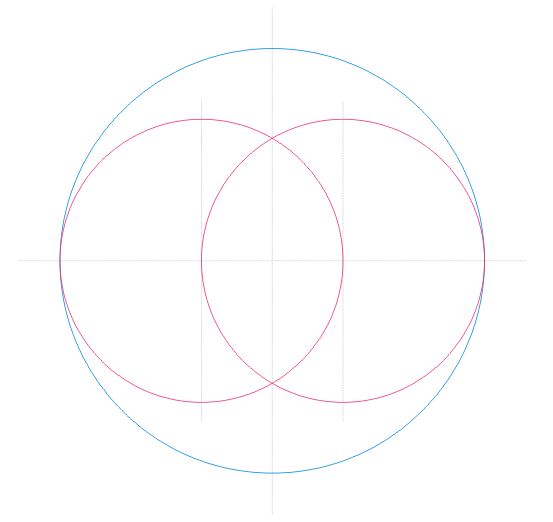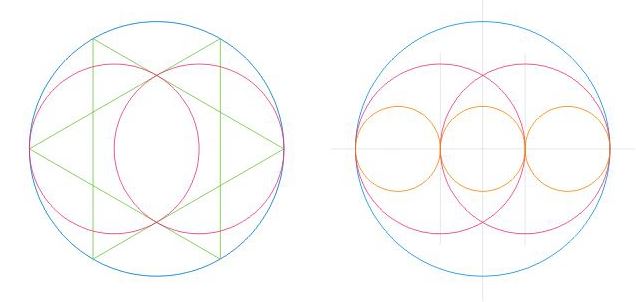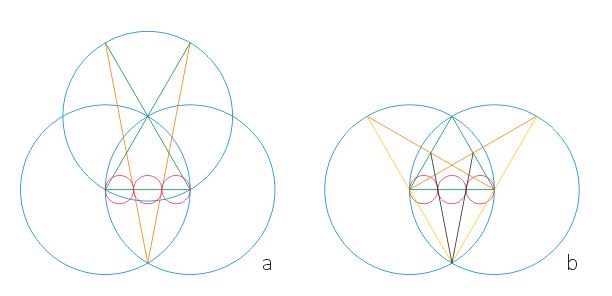| Author |
Message |
Jasper B.

|
 Posted: Wed 13 Jan, 2021 9:22 am Post subject: Geometric design - find 2:3 ratio Posted: Wed 13 Jan, 2021 9:22 am Post subject: Geometric design - find 2:3 ratio |
 |
|
Hi,
This is a geometry question rather than a historic weapon question I guess, but it came up in my attempts to design a sword using geometry.
(see attachment)
It is quite easy to work from the inside out: create the (smaller) circle and it's neighbour, then enclose the two in a (larger) circle.
I'm however struggling to do the reverse: find to the two (smaller) circles inside the larger one. Is there a practical (the 'common') method to construct the 2:3 ratio, inside a circle.
~Jasper
 Attachment: 23.97 KB Attachment: 23.97 KB

vesica inside circle
|
|
  |
 |
|
Mark Millman
|
 Posted: Wed 13 Jan, 2021 10:26 am Post subject: Posted: Wed 13 Jan, 2021 10:26 am Post subject: |
 |
|
Dear Jasper,
After a (very brief!) search, it seems that the most expeditious method is to circumscribe a square about the circle, and then divide the square into thirds.
I hope that this proves helpful.
Best,
Mark Millman
|
|
  |
 |
Jasper B.

|
 Posted: Wed 13 Jan, 2021 10:55 am Post subject: Posted: Wed 13 Jan, 2021 10:55 am Post subject: |
 |
|
Thanks for your answer.
From your answer I gather that I should have expanded my post and point out that I did not post this question at the start of my search, but rather at the dead-end of it. But I did not, because I did not want to steer the answer with the solutions I already have, but hoped for an approach that I did not yet know about, that is easy and convenient to use and in line with the other methods used in the medieval period.
The most common method of dividing a line into 3 equal segments reasonably complicated and involves drawing lines parallel to each other (or at least, that is the common method I know).
I don't know enough about medieval geometry to know if parallel lines were part of their toolbox, but it feels quite different and far less elegant than 'simply' using a compass to work out the dimensions. So I was wondering if there was a more practical/elegant method of coming up with the division into three.
I also found a method (well, two closely related methods) to construct the division into three equal parts using circles, but again, it is quite complicated and as such feels like quite a step outside the elegant compass work that seems to be used to do most of the laying-out of a sword design.
So I was hoping there is a more elegant solution to drawing the two circles inside a the larger one.
 Attachment: 27.29 KB Attachment: 27.29 KB

 Attachment: 25.7 KB Attachment: 25.7 KB

|
|
  |
 |
|
Mark Millman
|
 Posted: Wed 13 Jan, 2021 8:09 pm Post subject: Posted: Wed 13 Jan, 2021 8:09 pm Post subject: |
 |
|
Dear Jasper,
No, my suggestion is a compass-and-straightedge method that is plausible--although I don't know whether it actually was used--as a medieval geometric construction. I did consider suggesting that you take a piece of string of the circle's diameter and fold it into thirds, which would be the fastest method (and is reasonably accurate and was very likely used), but it's pretty clear from your post what you want.
Circumscribing a square about a circle with compass and straightedge is well understood, so I won't give a reference here. For a straightedge-only method of dividing a square into thirds without measurements, see this YouTube video.
Again, I hope that this proves helpful.
Best,
Mark Millman
|
|
  |
 |
|
T. Kew
Location: London, UK Joined: 21 Apr 2012
Posts: 256
|
 Posted: Thu 14 Jan, 2021 9:47 am Post subject: Posted: Thu 14 Jan, 2021 9:47 am Post subject: |
 |
|
I would recommend the reverse approach. Instead of saying "I want these proportions, how can I construct them?" say "what are the natural proportions I can construct?" Peter Johnsson's notes on geometric designs lay out some common 'patterns' - ratios and simple elements which are often seen - and by applying those patterns you will be much more likely to end up with a sword that 'feels' geometrically harmonious in a medieval fashion.
HEMA fencer and coach, New Cross Historical Fencing
|
|
  |
 |
Jasper B.

|
 Posted: Thu 14 Jan, 2021 10:09 am Post subject: Posted: Thu 14 Jan, 2021 10:09 am Post subject: |
 |
|
Mark, thanks for you answer!
Especially the comment about using a piece of string is a really simple solution, I'm clearly bound too rigidly with my thinking.
Apart from that, the method shown in the youtube video you linked is indeed much easier than the methods I knew about.
T. Kew, yes, this is in part what I did. The 'vesica within a circle' seems to be common pattern. It is easy to just apply the patterns from the book with vector drawing software, but that's not the same as drawing them with a compass and ruler. To explore this further, I now try to draw the weapons designs on paper. The problem is that I do not know how to construct some of the common patterns described by Peter Johnsson, because my geometry skills are (severely) lacking. If I don't explore what is easy to draw and how to do it, I'll never get any better :-)
|
|
  |
 |
|
T. Kew
Location: London, UK Joined: 21 Apr 2012
Posts: 256
|
 Posted: Thu 14 Jan, 2021 11:20 am Post subject: Posted: Thu 14 Jan, 2021 11:20 am Post subject: |
 |
|
The basic element of most of the geometric constructions is a simple circle, repeated with a half diameter offset. This naturally creates vesicae between each circle. However, subdividing one of those circles in the way you're looking to do isn't a pattern I recall being frequently shown - potentially because it's a much more complex pattern to construct.
HEMA fencer and coach, New Cross Historical Fencing
|
|
  |
 |
|
Mark Millman
|
 Posted: Thu 14 Jan, 2021 3:27 pm Post subject: Posted: Thu 14 Jan, 2021 3:27 pm Post subject: |
 |
|
Dear Jasper,
You're very welcome. I'm glad I was able to help.
Best,
Mark
|
|
  |
 |
|
|

